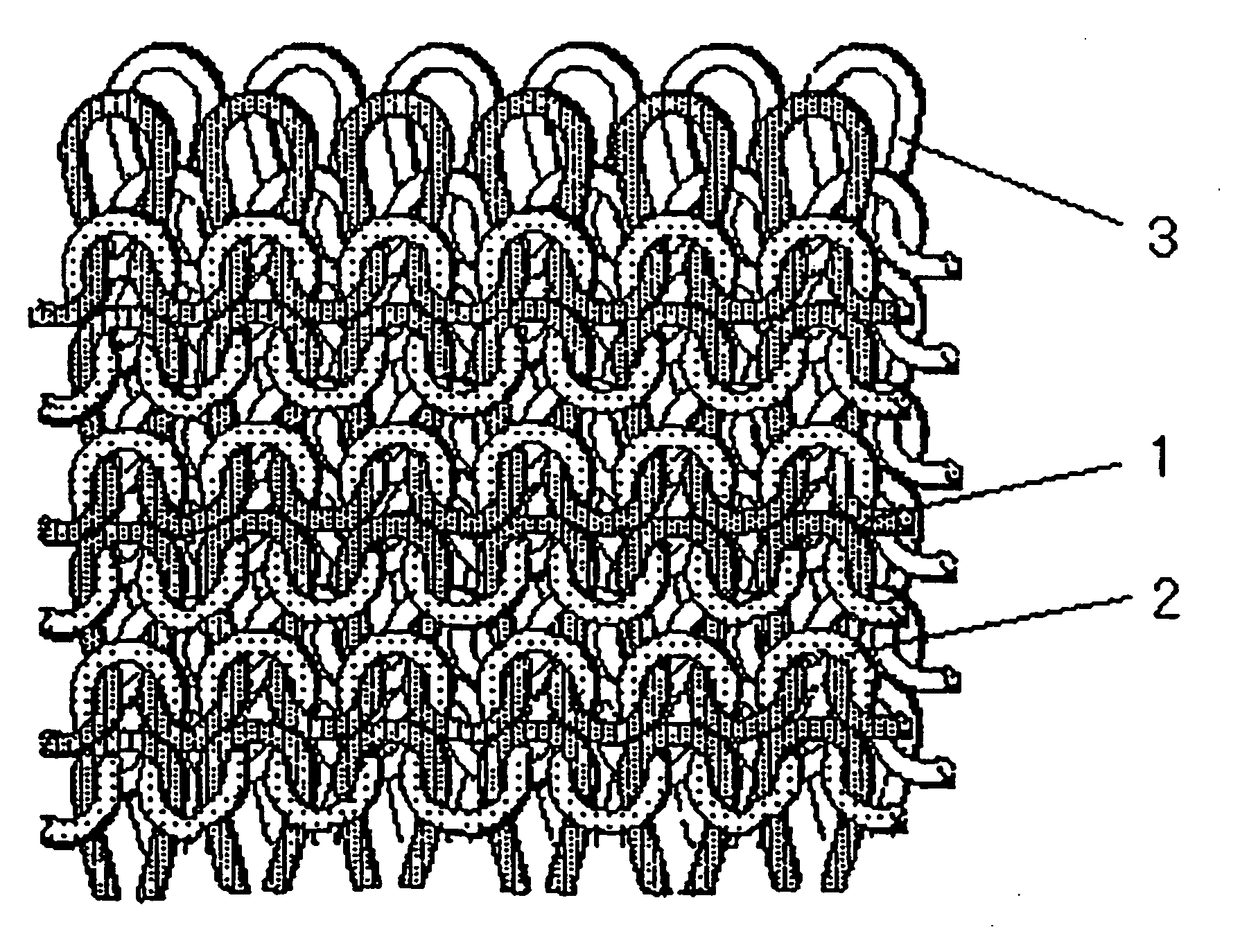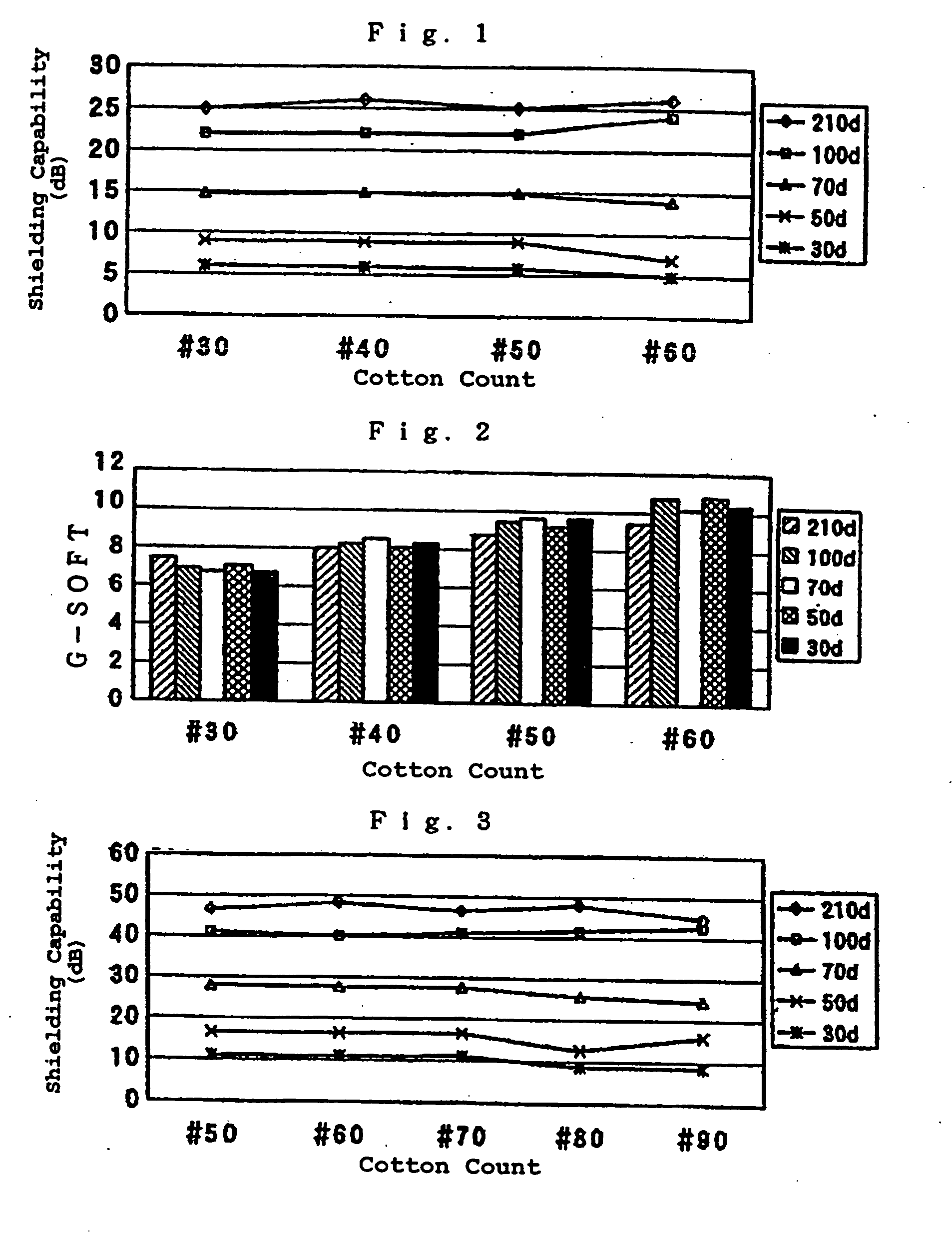Electromagnetic wave shielding knitted material and electromagnetic wave shielding garment
a technology of electromagnetic shielding and knitted materials, applied in knitting, ornamental textile articles, nuclear elements, etc., can solve the problems of not being able to completely shield electromagnetic wave sources, unable to meet the requirements of shielding measures only on electromagnetic wave sources, and disclosed techniques are not capable of completely shielding electromagnetic wave sources
- Summary
- Abstract
- Description
- Claims
- Application Information
AI Technical Summary
Benefits of technology
Problems solved by technology
Method used
Image
Examples
example 1
[0096] Used were silver-plated nylon multifilament yarns (“X-static” manufactured by Sauquit) of a variety of deniers as conductive fibers, and cotton yarns of variety of counts. The two types of yarns were aligned and fed to a 24.5 gauge plain knitting machine to carry out plating in all the courses, to prepare knitted materials with a reversible structure comprising a surface layer made of a cotton yarn and a back layer made of a conductive fiber yarn, the two layers being integrally laminated.
[0097] Using the knitted materials, undergarments were sewn which had the cotton yarn knit layer on the inside and the conductive fiber knit layer on the outside.
[0098]FIG. 1 shows the components and performance evaluation results (hand evaluation value of the knitted materials: G-soft; electromagnetic wave shielding capability (dB) measured by KEC method at 800 MHz). The figure reveals that the reversible knitted materials with a 24.5 gauge plain knit structure had a necessary electromagn...
example 2
[0101] Using the same conductive fiber yarns and cotton yarns as in Example 1, the knitting operation of Example 1 was repeated except that the knit structure was changed to 18.6 gauge rib knitting. Thus, the two types of yarns were aligned and fed to a rib knitting machine to carry out plating in all the courses, to prepare reversible knitted materials comprising a surface layer made of a cotton yarn and a back layer made of a conductive fiber yarn. Using this knitted materials, shirts (undergarments) for wearing tests were sewn in the same manner as in Example 1. Further, performance evaluation was carried out in the same manner as in Example 1.
[0102]FIG. 3 shows the evaluation results, which were similar to the evaluation results obtained in Example 1. FIG. 3 also reveals that, when the conductive fiber knit yarn layer is made by rib knitting, it is necessary to use a conductive fiber yarn of at least 70 d / 34 f to achieve a required electromagnetic wave shielding capability (20 ...
example 3
[0106] Used were a 200 d silver-plated nylon yarn (“X-STATIC” manufactured by SAUQUIT) as a conductive fiber yarn, a single-covered yarn comprising a 20 d polyurethane stuffing thread covered with a 30 d nylon thread as an elastic fiber yarn, and a No. 30 count cotton yarn as a natural fiber yarn. The yarns were knitted to prepare a reversible plain knitted material of the present invention, which comprised a surface side made of the silver-plated nylon yarn and the single-covered yarn interknitted at a ratio of 1:1 (the proportion of the single-covered yarn being 1 / 2) and a back side (the side that would come into contact with the skin) made of the cotton yarn. The obtained material was cut and sewn in a routine manner to obtain an undergarment. FIG. 6 shows the relation between electromagnetic wave shielding capability and cost of the undergarment. The electromagnetic wave shielding capability is expressed in a value relative to a reference sample, based on the magnetic field shie...
PUM
| Property | Measurement | Unit |
|---|---|---|
| Length | aaaaa | aaaaa |
| Length | aaaaa | aaaaa |
| Length | aaaaa | aaaaa |
Abstract
Description
Claims
Application Information
 Login to View More
Login to View More - R&D
- Intellectual Property
- Life Sciences
- Materials
- Tech Scout
- Unparalleled Data Quality
- Higher Quality Content
- 60% Fewer Hallucinations
Browse by: Latest US Patents, China's latest patents, Technical Efficacy Thesaurus, Application Domain, Technology Topic, Popular Technical Reports.
© 2025 PatSnap. All rights reserved.Legal|Privacy policy|Modern Slavery Act Transparency Statement|Sitemap|About US| Contact US: help@patsnap.com



